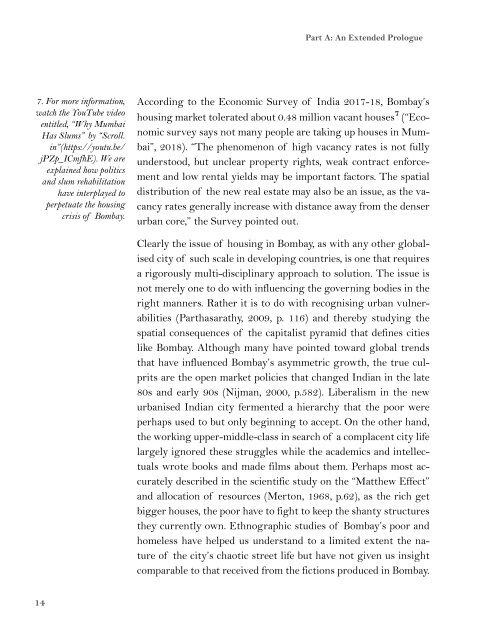Dwelling In (On) Bombay Cinema
Dwelling In (On) Bombay Cinema is an experimental research into the domestic condition of Bombay through a reading of Bombay cinema. It composes of an audio-visual product and the following textual documentation of the investigation methodology. These two entities are intended to be archived together digitally and physically. This work is part of the final assignment (trabajo fin de máster) of the masters programme in architectural communication or MAca (Máster Universitario en Comunicación Arquitectónica ) in the Superior Technical School of Architecture of Madrid (Escuela Técnica Superior de Arquitectura de Madrid) under the Technical University of Madrid (Universidad Politécnica de Madrid). The following document is to accompanied by the digital essay-film available through the following link: https://youtu.be/OO8dxD5Ypos The investigation is authored by Akshid Rajendran. And tutored by Atxu Amann y Alcocer and Samuel Fuentes. January 2019.
Dwelling In (On) Bombay Cinema is an experimental research into the domestic condition of Bombay through a reading of Bombay cinema. It composes of an audio-visual product and the following textual documentation of the investigation methodology. These two entities are intended to be archived together digitally and physically. This work is part of the final assignment (trabajo fin de máster) of the masters programme in architectural communication or MAca (Máster Universitario en Comunicación Arquitectónica ) in the Superior Technical School of Architecture of Madrid (Escuela Técnica Superior de
Arquitectura de Madrid) under the Technical University of Madrid (Universidad Politécnica de Madrid).
The following document is to accompanied by the digital essay-film
available through the following link: https://youtu.be/OO8dxD5Ypos
The investigation is authored by Akshid Rajendran.
And tutored by Atxu Amann y Alcocer and Samuel Fuentes.
January 2019.
You also want an ePaper? Increase the reach of your titles
YUMPU automatically turns print PDFs into web optimized ePapers that Google loves.
Part A: An Extended Prologue<br />
7. For more information,<br />
watch the YouTube video<br />
entitled, “Why Mumbai<br />
Has Slums” by “Scroll.<br />
in”(https://youtu.be/<br />
jPZp_ICmfhE). We are<br />
explained how politics<br />
and slum rehabilitation<br />
have interplayed to<br />
perpetuate the housing<br />
crisis of <strong>Bombay</strong>.<br />
According to the Economic Survey of <strong>In</strong>dia 2017-18, <strong>Bombay</strong>’s<br />
housing market tolerated about 0.48 million vacant houses 7 (“Economic<br />
survey says not many people are taking up houses in Mumbai”,<br />
2018). “The phenomenon of high vacancy rates is not fully<br />
understood, but unclear property rights, weak contract enforcement<br />
and low rental yields may be important factors. The spatial<br />
distribution of the new real estate may also be an issue, as the vacancy<br />
rates generally increase with distance away from the denser<br />
urban core,” the Survey pointed out.<br />
Clearly the issue of housing in <strong>Bombay</strong>, as with any other globalised<br />
city of such scale in developing countries, is one that requires<br />
a rigorously multi-disciplinary approach to solution. The issue is<br />
not merely one to do with influencing the governing bodies in the<br />
right manners. Rather it is to do with recognising urban vulnerabilities<br />
(Parthasarathy, 2009, p. 116) and thereby studying the<br />
spatial consequences of the capitalist pyramid that defines cities<br />
like <strong>Bombay</strong>. Although many have pointed toward global trends<br />
that have influenced <strong>Bombay</strong>’s asymmetric growth, the true culprits<br />
are the open market policies that changed <strong>In</strong>dian in the late<br />
80s and early 90s (Nijman, 2000, p.582). Liberalism in the new<br />
urbanised <strong>In</strong>dian city fermented a hierarchy that the poor were<br />
perhaps used to but only beginning to accept. <strong>On</strong> the other hand,<br />
the working upper-middle-class in search of a complacent city life<br />
largely ignored these struggles while the academics and intellectuals<br />
wrote books and made films about them. Perhaps most accurately<br />
described in the scientific study on the “Matthew Effect”<br />
and allocation of resources (Merton, 1968, p.62), as the rich get<br />
bigger houses, the poor have to fight to keep the shanty structures<br />
they currently own. Ethnographic studies of <strong>Bombay</strong>’s poor and<br />
homeless have helped us understand to a limited extent the nature<br />
of the city’s chaotic street life but have not given us insight<br />
comparable to that received from the fictions produced in <strong>Bombay</strong>.<br />
14




